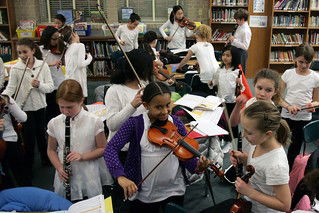What’s The Difference Between a Concert Band and a Wind Symphony?

(If you found this article without going through the website, be sure to explore it when you’re done reading. It’s at www.Salt-Cellar-Creations.com )
Music is a universal language that transcends borders and unites people through its captivating melodies and harmonious sounds. Among the various genres and ensembles, concert bands and wind symphonies stand as prominent representatives of wind instrument ensembles. While the two may seem similar at first glance, they possess distinct characteristics that set them apart. This article explores the difference between a concert band and a wind symphony, shedding light on their history, instrumentation, repertoire, and performance styles.
Both concert bands and wind symphonies have their roots in the rich history of wind instrument ensembles. Concert bands emerged during the 19th century in Europe, primarily as military bands performing ceremonial music and marches. These bands transitioned into more diverse repertoires over time, incorporating a variety of musical styles.
Wind symphonies, on the other hand, trace their origins back to the early 20th century when composers sought to elevate the status of wind instruments in orchestral settings. Inspired by the harmonious sounds of traditional symphony orchestras, composers like Gustav Holst and Percy Grainger experimented with creating symphonic music solely using wind instruments.
The primary distinction between a concert band and a wind symphony lies in their instrumentation. A typical concert band features a broader range of instruments, including woodwinds, brass, and percussion. The woodwind section typically includes flutes, clarinets, oboes, and bassoons, while the brass section comprises trumpets, trombones, French horns, and tubas. Additionally, the percussion section contributes an array of rhythm and color, with instruments like snare drums, bass drums, cymbals, and timpani.
Conversely, a wind symphony exclusively consists of wind instruments, omitting percussion entirely. This restriction creates unique challenges and opportunities for composers to explore innovative ways to achieve rhythmic and percussive effects within the confines of wind instruments.
A composition for concert band can create excitement and bravado with its percussion section, while a wind orchestra must do so with wider dynamics, and the use of various articulations that range from staccato to legato.
The difference in instrumentation naturally impacts the repertoire of concert bands and wind symphonies. Concert bands possess a vast collection of music, ranging from traditional marches and transcriptions of orchestral works to contemporary compositions. Their repertoire encompasses a diverse range of styles, including classical, pop, jazz, and film music. With the inclusion of percussion instruments, concert bands are capable of producing a fuller and more diverse sound.
On the other hand, wind symphonies focus exclusively on works written or transcribed specifically for wind instruments. Composers like Alfred Reed and Frank Ticheli have contributed significantly to the wind symphony repertoire, composing original pieces that fully exploit the potential of wind instruments. This dedicated repertoire encourages exploration and experimentation with the unique sonorities and capabilities of wind instruments. As long as an instrument uses breath to sound, it can be included in a wind symphony. There have even been concertos written for harmonica.
The performance style of concert bands and wind symphonies differs due to their distinct musical identities. Concert bands often perform in various settings, such as outdoor venues, concert halls, and community events. Their versatility allows them to adapt to a wide array of musical genres and cater to diverse audiences. The presence of percussion adds an energetic and rhythmic dimension to their performances.
On the other hand, wind symphonies are more commonly associated with formal concert settings, performing in traditional concert halls. Their focus on original wind music allows for a more refined and delicate approach to musical expression. Wind symphonies often highlight the unique timbres of each wind instrument, resulting in a rich and expressive ensemble sound.
Another point of distinction between the two ensembles is the level of difficulty in their repertoire. Concert bands often cater to musicians of varying skill levels, from beginners to advanced players. This inclusivity makes concert band music accessible to a broader range of performers, encouraging community involvement and music education.
Wind symphonies, being more specialized, generally require a higher level of technical proficiency from their members. The absence of percussion can make the performance more challenging, demanding precise intonation, phrasing, and dynamic control. Consequently, wind symphonies are often comprised of skilled and experienced wind musicians.
In a nutshell, concert bands and wind symphonies, despite both being wind instrument ensembles, exhibit distinct characteristics that set them apart. While concert bands feature a broader instrumentation, diverse repertoire, and a more versatile performance style, wind symphonies focus exclusively on wind instruments, boasting a specialized repertoire and more refined performances. Both ensembles contribute significantly to the world of music, allowing audiences to experience the enchanting power of wind instruments in their own unique ways.
Salt Cellar Creations has a number of great Concert Band music written specifically for High School or Community Bands. Explore them HERE.
Wind Orchestras have much fewer options for good music. Salt Cellar Creations can adapt some of its repertoire of Concert Band pieces or even its String Orchestra (click for the collection) works for Wind Orchestra. Please CONTACT ME with your requests.